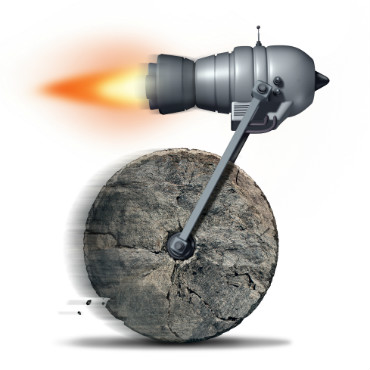Virtual roadblocks to modernization

Our aging federal IT infrastructure is a big impediment to using state-of-the-art tech applications for government service delivery.

In his joint address to Congress, President Donald Trump doubled down on his commitment to modernizing the country's physical infrastructure. To accomplish this mission, it's vital that the federal government dedicate the resources that are required to sustain the rebuilding project for decades. However, it is not only the nation’s physical infrastructure that requires a facelift but the IT infrastructure as well.
Just as our society depends on physical infrastructure assets and architecture to support our daily activities and commerce, we rely on IT infrastructure and architecture. Commercial companies provide applications and platforms that give us the ability to conduct almost any form of business or entertainment from our smartphones.
However, defense and civilian agencies struggle to provide speedy applications and trusted networks to deliver citizen services. Similar to the aged bridges and deteriorating roads across the nation, federal agencies face virtual IT roadblocks caused by antiquated systems, networks and architectures.
The federal government must have modern, reliable and secure technology that can keep up with the needs of citizens and federal employees alike. Creating an easily adaptable digital infrastructure will enable federal agencies to reap the benefits of faster network speeds and application performance, which will ultimately improve citizen and user experience for years to come. When we talk infrastructure improvements for the nation, we must include the IT component.
Drive the mission with automated technology
We're living in the age of innovation, where digitization, automated systems and the Internet of Things streamline formerly tedious tasks with the click of a button. Americans have grown accustomed to automation at home, so why should this modern technology be out of reach for the federal worker?
Unfortunately, when it comes to employing automated IT systems, the federal government lags behind the private sector; agencies are still using technology that is several decades old. In fact, a report from the Government Accountability Office suggests that in 2015, the federal government spent $55 billion, about 75 percent of its total IT budget, to support legacy IT. This means that it is almost impossible for most agencies to rebuild and modernize their IT infrastructure.
The U.S. Digital Service has worked to streamline government processes by updating antiquated systems with state-of-the-art tools. But USDS's work isn't done, which is why it's critical for the federal government to maintain digital programs. The adoption of automated systems and other digital efforts, including cloud migration, will ensure that the government accomplishes key mission objectives while saving valuable taxpayer dollars.
However, this process stretches beyond simply adopting automated systems. A shift from a focus on application management to platform management and enterprise service delivery is required to get governmental agencies up to speed. Government can no longer afford to buy common capabilities in legacy fashion -- meaning each agency makes isolated decisions and chooses unique and, in many cases, proprietary solutions, to single-threaded problems. Governments must be supported like large, multi-division global enterprises. This shift in mindset is critical to embracing the transformational power of enterprise service delivery platforms.
Leverage FITARA to enhance productivity
The House Oversight and Government Reform Committee will continue to release the semiannual results of the Federal Information Technology Acquisition Reform Act scorecards this year, so it will be beneficial for the Trump administration to emphasize the importance of this law over time. It is likely that the tone of FITARA may evolve as Congress makes appropriate revisions to the scorecard guidelines; however, FITARA will remain the foundation of the federal government's digital transformation.
Throughout the presidential race, candidate Trump discussed the effectiveness of the federal government and raised the question of whether or not federal leaders were truly productive. FITARA can help Congress break down agency silos by regularly monitoring the performance and progress of federal IT leaders.
Additionally, FITARA can foster increased collaboration and communication between agency leaders. As former Federal CIO Tony Scott explained in an exit interview, the success of FITARA is predicated upon agency teamwork and communication among agency executives.
"One of the big lessons learned though, some thought of this as just CIO authorities, whether it's hiring or budget, but as we have gotten into implementation, almost every agency has realized this has to be a team effort between the CFOs, the chief human resource officers, the undersecretary for management and a bunch of different players can serve as enablers of the intent of FITARA," Scott said.
The federal government won't undergo a complete digital transformation overnight or even in the first 100 days President Trump's term. It'll take time, but it's not a pipe dream. By prioritizing and leading the effort to modernize the federal government's digital landscape, IT modernization across federal agencies will surely be successful.
For these reasons, the Trump administration must now place a greater emphasis on the federal government's IT infrastructure, policies and resources to create a sound digital enterprise across federal agencies, increasing capabilities and reducing redundancy and costs for years to come.
NEXT STORY: Oversight chief won't seek new term


